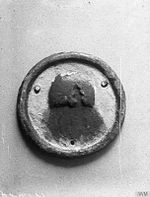HMS Intrepid (1891)

HMS Intrepid in her original configuration, 1896 (IWM Q21388)
|
|
| History | |
|---|---|
|
|
|
| Name: | HMS Intrepid |
| Builder: | London and Glasgow Shipbuilding Company |
| Laid down: | 6 September 1889 |
| Launched: | 20 June 1891 |
| Commissioned: | November 1892 |
| Honours and awards: |
ZEEBRUGGE 1918 |
| Fate: | Expended as a block ship, 1918 |
| Badge: | |
| General characteristics | |
| Class and type: | Apollo-class cruiser |
| Displacement: | 3,600 tons |
| Length: | 314 ft (95.7 m) |
| Beam: | 43.5 ft (13.3 m) |
| Draught: | 17.5 ft (5.3 m) |
| Propulsion: |
|
| Speed: | 19.75 knots (36.58 km/h) |
| Complement: | 273 to 300 (Officers and Men) |
| Armament: |
|
HMS Intrepid was an Apollo-class protected cruiser of the Royal Navy built on the River Clyde and launched in 1891. She was subsequently converted as a minelayer and sunk as a blockship during the Zeebrugge Raid on 23 April 1918.
Ordered under the Naval Defence Act 1889, Intrepid was laid down in 1889 at the yard of the London and Glasgow Shipbuilding Company. Following completion in November 1892 Intrepid was held at Portsmouth. During 1896-99 she served on the Noth America & West Indian Station, then in 1899 returned to Portsmouth. Between 1902 and 1904 she served in the Mediterranean, followed by harbour service at Portsmouth until 1909.
Along with a number of other ships of her class, as she became obsolete as a cruiser she was converted at Chatham Dockyard into a minelayer, carrying 100 mines and with armament reduced to four 4.7-inch guns. In 1910 she recommissioned at Chatham. On the outbreak of the First World War Intrepid was based at Dover, undertaking minelaying duties as part of the Dover Patrol.
In 1915-16 she became a Depot ship, North Russia. In 1917 she was in use as a depot ship in the White Sea as part of the British North Russia Squadron.
Along with HMS Iphigenia (1891) and HMS Thetis she was selected to be used as a blockship during the Zeebrugge Raid. She was prepared for the raid by being filled with cement. She was sunk at the entrance to the Bruges Canal to try and prevent it being used by German U-Boats. She was subsequently broken up when the canal was cleared.
...
Wikipedia

